 Contents
Contents Contents
ContentsAlyogyne is an Australian genus of xerophytic Malvaceous shrubs, distantly related to, and formerly classified in the genus Hibiscus. The genus is distinguished from Hibiscus by the undivided style. There are 4 recognised species, cuneiformis, hakeifolia, huegelii and pinoniana. Two of these species, the Blue Hibiscus, Alyogyne huegelii, and the Red-centred Hibiscus, Alyogyne hakeifolia, are cultivated as decorative shrubs.
Species of the genus are distributed in Western Australia, Southern Australia and the Northern Territory, as indicated on the map above.
Alyogynes have stellate hairs on various parts. The flowers are borne solitarily in leaf axils. They possess an epicalyx composed of 4 to 10 bracteoles fused towards the base. The petals are large, of various colours, and usually with a constrasting basal spot. The anthers are borne in rings along the staminal column. The style is unbranched, with a 5-lobed decurrent stigma. The fruit is a 5-celled dehiscent capsule. The seeds are often woolly.
Classification
The genus was erected in 1863 by Alefeld for Giardano's Hibiscus hakaeifolius. To this Lewton (1915) later transferred the coastal Hibiscus cuneiformis DC., and Fryxell (1968) Hibiscus pinonianus C. Gaudichaud-Beaupré and Hibiscus huegelii Endl.
Lewton used the orthographic variant Allogyne, and references might be found under that spelling.
The taxonomic position of Alyogyne is uncertain. It has been associated with Hibiscus, with the cottons (Cienfuegosia/Fugosia), and with the Norfolk Island Hibiscus (Lagunaria). Kubitzki & Bayer5 place it as an anomalous genus in the cotton tribe (Gossypieae) on the basis of work by La Duke and Doebley, although it lacks the gossypol glands (small glandular structures containing a class of antifeedant chemicals known as gossypols) otherwise characteristic of Gossypieae. Hutchinson6 not only placed it in Gossypieae, but reduced it to synonymy with Cienfuegosia. However, the cpDNA studies of Pfeil et al4, are equivocal as to the correct placement of Alyogyne.
The generic name is derived from the Greek alytos united or undivided and gyne woman or female, and is said to be a reference to the unbranched style.
The genus is currently being revised, with the resurrection of some species previously sunk in the 4 species described herein, and the introduction of other species. An outline of the revised classification, as it applies to the Western Australian species, is available at FloraBase (Western Australian Herbarium).
Alyogyne cravenii Fryxell is correctly Hibiscus cravenii (Fryxell) B.E. Pfeil & Craven.7
Description
Alyogyne are much-branched shrubs. They have a covering of stellate hairs on various parts. The flowers are borne solitarily in leaf axils. They are large, and of various colours including lilac, mauve, violet, blue, pink, white and yellow, often with a darker spot at the base of the petals. The flowers possess an epicalyx composed of 4 to 10 linear or awl-shaped bracteoles, which are joined at the base. The calyx is 5-lobed. The fruit is a dehiscent 5-celled capsule. The seeds are often woolly.
Alyogyne huegelii (Endl.) P.A. Fryxell
![]() Blue Hibiscus, Lilac Hibiscus, Purple Hibiscus
Blue Hibiscus, Lilac Hibiscus, Purple Hibiscus
![]() Seideneibisch, Blauer Hibiscus
Seideneibisch, Blauer Hibiscus
![]() Blauwe malve
Blauwe malve
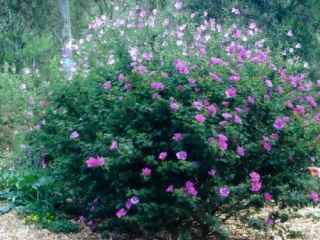 Alyogyne huegelii is a
variable species. Florabase
(Western Australia) lists 5 varietal forms, two of which represent the
reduction to varietal status of forms previously described as separate species
in the genus Hibiscus.
Alyogyne huegelii is a
variable species. Florabase
(Western Australia) lists 5 varietal forms, two of which represent the
reduction to varietal status of forms previously described as separate species
in the genus Hibiscus.
The specific name is in honour of Baron Karl Alexander von Hügel, a 19th century Austrian botanist.
It is most commonly known as the Blue Hibiscus, though this is a misnomer with respect to the typical flower colour (though there are some photographs online which may fairly be described as blue). The alternative names of Lilac Hibiscus and Purple Hibiscus more accurately represent the flower colour. The flowers are hibiscus-like, appear from spring through summer to autumn, are 3"-5" in diameter, and range in colour from pink to lilac, mauve and deep purple, sometimes with a paler eye. White and yellow forms also occur. The individual flowers are short-blooming, only lasting a day or two, but new flowers continue to open over a long period.
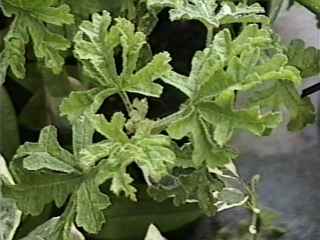 The plant is a fast-growing, open, spreading shrub, typically
reaching 1m or more in height and spread, but can reach twice this size, found
in sandy and sandy-gravel soils in South Australia and Western Australia. It
has bright green, wrinkled, complexly 5-lobed, usually tomentose, leaves, up to
3" in length, varying markedly in the degree of dissection. The species
also displays the common malvaceous characteristic of variation between basal
and floral leaves. The branches are also tomentose, and are also roughened.
The plant is a fast-growing, open, spreading shrub, typically
reaching 1m or more in height and spread, but can reach twice this size, found
in sandy and sandy-gravel soils in South Australia and Western Australia. It
has bright green, wrinkled, complexly 5-lobed, usually tomentose, leaves, up to
3" in length, varying markedly in the degree of dissection. The species
also displays the common malvaceous characteristic of variation between basal
and floral leaves. The branches are also tomentose, and are also roughened.
The white flowering form is reported to have a more sprawling growth habit and brighter green leaves.
Alyogyne huegelii is in cultivation, primarily in Australia and the SW USA, but also in Europe, where it is grown as a conservatory plant. In the former areas is a hardy and adaptable shrub, which is lime, drought and frost tolerant. It requires a well drained soil, but can be grown in sand, loam or clay soils. It can be grown in full sun, or in partial shade. Protection from strong winds is desirable. It is described as suitable for USDA zones 9 and 10, though in wet areas it may be necessary to grow it in containers, or to graft it onto other species of Hibiscus. Although it has a degree of frost tolerance, and has been reported to tolerate 12°C of frost for short periods without permanent damage, it is not be suitable for growing in the ground in temperate climates, either due to longer and deeper periods of frost in continental climates, or to winter wet in maritime climates. In such climates there is the option of growing the plant as a conservatory or patio shrub. In mild areas grown as a wall shrub with a sheltered sunny aspect and a well drained soil it may survive for a few years, but will probably be seen off by the first cold or wet winter.
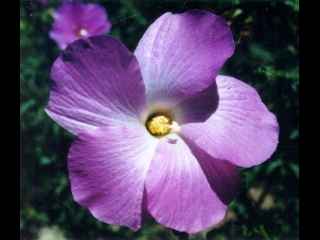 If unpruned Alyogyne
huegelii becomes a little sparse of foliage on lower branches, and may also
become straggly. It can be pruned back quite hard after flowering, or
frequently and lightly during the flowering season. Pruning results in a
denser, more compact, and possibly more floriferous plant. It will throw out
vigorous fast-growing shoots from old wood, thus enabling it to be kept down to
a small compact shrub if desired.
If unpruned Alyogyne
huegelii becomes a little sparse of foliage on lower branches, and may also
become straggly. It can be pruned back quite hard after flowering, or
frequently and lightly during the flowering season. Pruning results in a
denser, more compact, and possibly more floriferous plant. It will throw out
vigorous fast-growing shoots from old wood, thus enabling it to be kept down to
a small compact shrub if desired.
Many Australian plants are phosphorus-sensitive, a consequence of adaption for nutrient-poor soils. Different sources are inconsistent as to whether Alyogyne huegelii comes into this category, and it may be wise to be cautious with the use of high-phosphorus fertilisers. It is possible to grow it without the use of chemical fertilisers, especially if the plants are well-mulched.
Little watering is required, especially if the plants are well mulched. Once established supplementary watering should be required only during extremely dry condition, but is tolerated provided the plants are in a well-drained position.
Alyogyne huegelii can be grown as a pot plant, and will flower and set seed in pots as small as 6" diameter.
The yellow-flowered form does not appear to be in cultivation, although the yellow-flowered form of the related Alyogyne hakeifolia is.
Propagation
Alyogyne huegelii can be grown from seed, which remains viable for a number years. Germination is assisted by scarification, i.e, by rubbing the seed against sandpaper or the equivalent to break through the hard protective coating and allow moisture to penetrate. Seed shown be sown in spring or early autumn, depending on the climate (to avoid exposing young plants to cold winters, or wet summers).
Alyogyne huegelii can also be readily propagated by cuttings. 4" semi-ripe cuttings are recommended, but soft cuttings can also be successful. Cuttings taken in spring generally establish well but cuttings can be taken in early autumn if summers are very wet and winters are not too severe.
Pests
In California scale insects and aphids can be a serious problem with this plant.
In Europe, when grown as a conservatory plant, or overwintered under glass, it can be seriously affected by greenhouse pests such as red spider mite.
Synonyms: Synonyms of Alyogyne huegelii include Hibiscus geranifolius Turcz., Hibiscus grossulariaefolius Miq., Hibiscus huegelii Endl., Hibiscus huegelii var. angulatus Benth., Hibiscus huegelii var. glabrescens Benth., Hibiscus huegelii var. leptochlamys Benth., Hibiscus huegelii var. wrayae (Lindley) Benth., Hibiscus meisneri Miq., Hibiscus pinonianus Miq. non Gaudich., Hibiscus wrayae Lindley and Paritium wrayae (Lindley) Walp.
Images
Alyogyne huegelii forms and cultivars
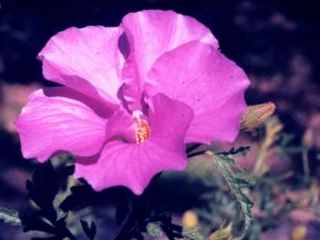 A number of cultivars of Alyogyne
huegelii are or have been available. Some of these may also have
Alyogyne hakeifolia in their ancestry.
A number of cultivars of Alyogyne
huegelii are or have been available. Some of these may also have
Alyogyne hakeifolia in their ancestry.
Images
Alyogyne hakeifolia (Giord.) Alefeld
![]() Red-centred Hibiscus, Desert Rose
Red-centred Hibiscus, Desert Rose
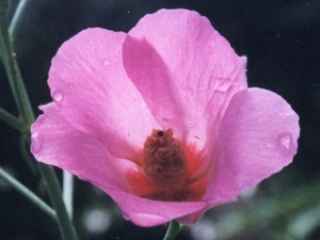 The Red-centred Hibiscus, Alyogyne hakeifolia is a small
to medium sized shrub.
The Red-centred Hibiscus, Alyogyne hakeifolia is a small
to medium sized shrub.
The specific name alludes to a similarity of the 'needle-like' foliage to that of Hakea.
The typical form of the species has mauve flowers with a darker red-eye, but there are also forms with white and yellow flowers, and lacking the dark eye. The flowers are in general less open in form - 'tulip-shaped' - than those of Alyogyne huegelii. The foliage is more deeply and more simply lobed than that of Alyogyne huegelii, dark-green in colour, and to 5" long. The individual lobes of the leaves can be so narrow as to make the foliage 'needle-like'.
The yellow-flowered form of hakeifolia is more common than the corresponding form of huegelii.
Alyogyne hakeifolia has a similar, but more inland, distribution to Alyogyne huegelii.
Like the Blue Hibiscus the Red-centred Hibiscus is grown as a garden plant. Same named cultivars are available (see below), but unnamed colour forms, including both the pink and pale-yellow, are more widely sold.
Cultivars
Synonyms: Synonyms of Alyogyne hakeifolia include Alyogyne lilacina (Lindley) Lewton, Alyogyne multifida (Paxton) Lewton, Cienfuegosia hakeifolia var. lilacina (Lindley) Hochr., Fugosia hakeifolia (Giord.) Hook., Fugosia hakeifolia var. coronopifolia (Miq.) Benth., Fugosia lilacinus G. Don ex Loud., Hibiscus coronopifolius Miq., Hibiscus hakeifolius Giard., Hibiscus lilacinus Lindley, Hibiscus multifidus Paxton and Lagunaria lilacina (Lindley) Sweet.
Alyogyne pinoniana (C.
Gaudichaud-Beaupré) Fryxell
![]() Sand Hibiscus
Sand Hibiscus
The Sand Hibiscus is a medium to tall (1-3m) sprawling shrub from the interior of Western Australia, South Australia and the Northern Territory. An isolated population, Alyogyne pinoniana var micrandra Fryxell, is found on the Fleurieu Peninsula of South Australia.
Alyogyne pinoniana flowers from late winter to early summer, with blue, lilac or mauve flowers, with deep red eyes, situated in leaf axils near the end of branches. The flowers are 7-9cm across. The leaves are variably, but often palmately lobed, and are heavily veined on the lower surface. Both leaves and stems are tomentose.
Synonyms: Hibiscus pinonianus C. Gaudichaud-Beaupré and Hibiscus solanifolium F. Muell. are synonyms of A. pinoniana
Images
Alyogyne cuneiformis (DC.) Lewton
![]() Coastal Hibiscus
Coastal Hibiscus
The Coastal Hibiscus (not to be confused with Talipariti tileaceum) is a small to medium sized shrub from the west coast of Western Australia (Carnarvon region). The tubular flowers are 6cm in length, and are white with a maroon (dark red) central eye. The leaves are thick and glabrous. They are composed of 3 forwards pointing cuneate (wedge-shaped) to spathulate (spoon-shaped) lobes.
Alyogyne cuneiformis has been in cultivation in Britain in the past, as a glasshouse plant.
Synonyms: Hibiscus cuneiformis DC., Cienfuegosia cuneiformis (DC.) Hochr., Fugosia cuneiformis (DC.) Benth. and Lagunaria cuneiformis G. Don are synonyms of Alyogyne cuneiformis.
Hybrids have arisen, or have been deliberately produced, in cultivation, between A. huegelii and A. hakeifolia. Named cultivars of this parentage are
The photograph of the foliage of Alyogyne huegelii is © 2001 Stewart Robert Hinsley. Other photographs are © G. Keena, and are reproduced with permission.
If you have found any errors on this page, or have any further information about the genus Alyogyne then please contact me at webmaster@meden.demon.co.uk.
© 2002, 2003, 2004 Stewart Robert Hinsley